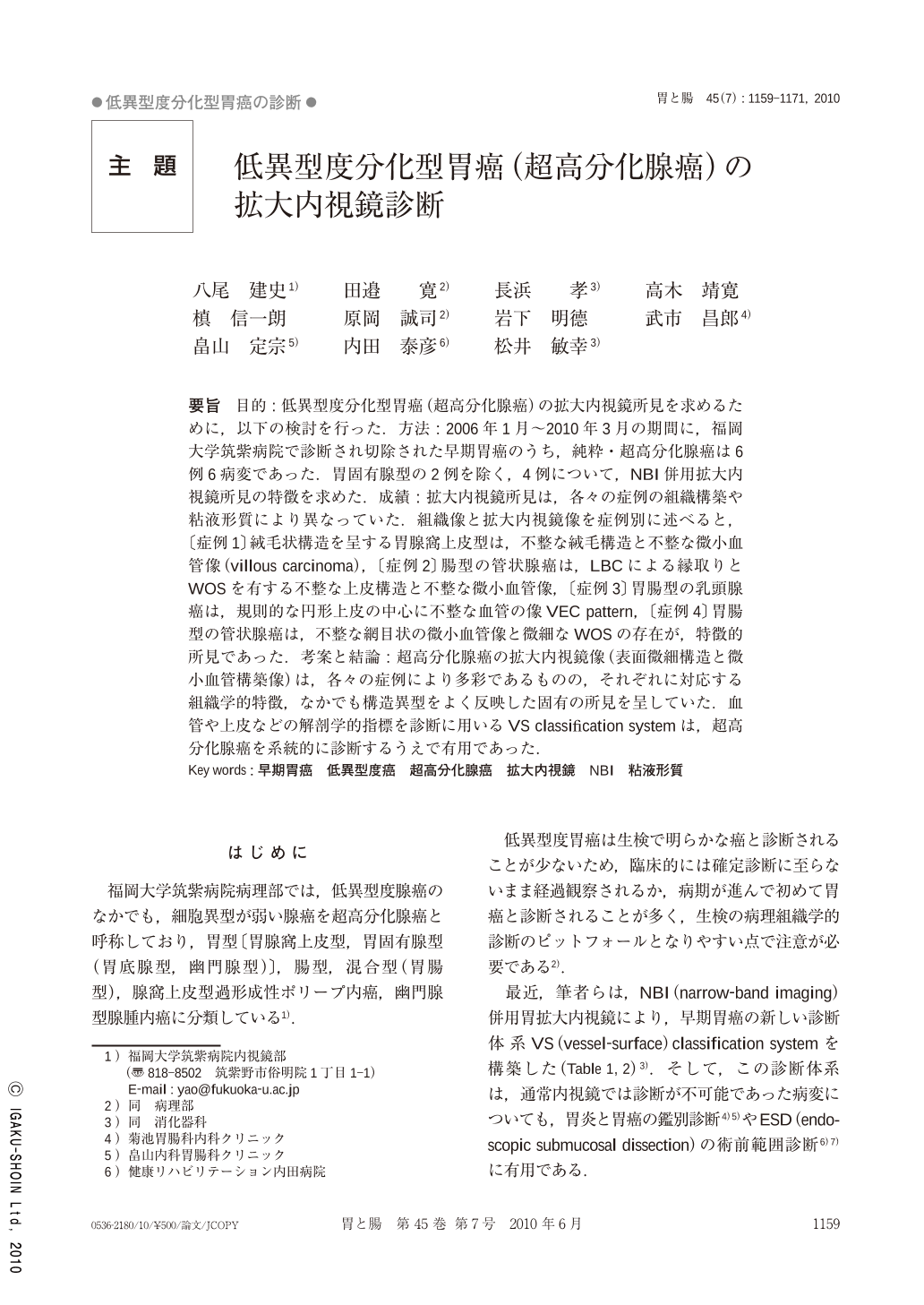Japanese
English
- 有料閲覧
- Abstract 文献概要
- 1ページ目 Look Inside
- 参考文献 Reference
- サイト内被引用 Cited by
要旨 目的 : 低異型度分化型胃癌(超高分化腺癌)の拡大内視鏡所見を求めるために,以下の検討を行った.方法:2006年1月~2010年3月の期間に,福岡大学筑紫病院で診断され切除された早期胃癌のうち,純粋・超高分化腺癌は6例6病変であった.胃固有腺型の2例を除く,4例について,NBI併用拡大内視鏡所見の特徴を求めた.成績:拡大内視鏡所見は,各々の症例の組織構築や粘液形質により異なっていた.組織像と拡大内視鏡像を症例別に述べると,〔症例1〕絨毛状構造を呈する胃腺窩上皮型は,不整な絨毛構造と不整な微小血管像(villous carcinoma),〔症例2〕腸型の管状腺癌は,LBCによる縁取りとWOSを有する不整な上皮構造と不整な微小血管像,〔症例3〕胃腸型の乳頭腺癌は,規則的な円形上皮の中心に不整な血管の像VEC pattern,〔症例4〕胃腸型の管状腺癌は,不整な網目状の微小血管像と微細なWOSの存在が,特徴的所見であった.考案と結論:超高分化腺癌の拡大内視鏡像(表面微細構造と微小血管構築像)は,各々の症例により多彩であるものの,それぞれに対応する組織学的特徴,なかでも構造異型をよく反映した固有の所見を呈していた.血管や上皮などの解剖学的指標を診断に用いるVS classification systemは,超高分化腺癌を系統的に診断するうえで有用であった.
Aims : We investigated the findings of magnifying endoscopy with narrow-band imaging characteristic for very-well differentiated gastric adenocarcinoma. Methods : We selected 4 cases of very-well differentiated adenocarcinomas from among the cases which were diagnosed in Fukuoka University Chikushi Hospital between January, 2006 and March, 2010. We reviewed all of the endoscopic findings together with histopathological findings obtained by hematoxylin & eosin staining and immunostaining. Results : The magnified endoscopic findings are different depending upon the histological structure and mucin phenotype. Characteristic findings of the histological structure and the magnified endoscopic findings according to each case are as follows : Case 1 with foveolar epithelial type showed irregular villous epithelial structure and irregular microvascular pattern(so called “villous carcinoma". Case 2 with intestinal epithelial type demonstrated distorted epithelial structure with light blue crest and white opaque substance with irregular microvascular pattern. Case 4 with gastric and intestinal phenotype represented a vessel within an epithelial circle(VEC)pattern. Case 4 with gastric and intestinal phenotype showed irregular reticular microvascular pattern with speckled white opaque substance. Conclusion : Each finding seemed to be specific for the respective phenotype of very well differentiated adenocarcinoma. Furthermore, the vessel-surface(VS)classification system was useful for making a correct diagnosis of very-well differentiated adenocarinoma.

Copyright © 2010, Igaku-Shoin Ltd. All rights reserved.


